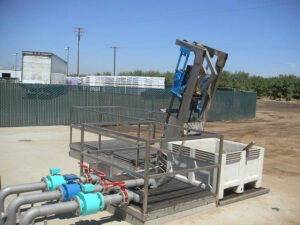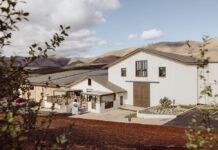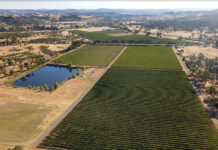
Since 2021, California winemakers have been assessing the State Water Resources Control Board’s Waste Discharge Requirements for Winery Process Water resolution, which mandates more wineries monitor, report and treat their process water. To meet the January 2024 deadline, wineries across the state have submitted their initial technical reports and filing fees to comply with this order aimed at preserving California’s overworked and polluted groundwater resources.
Wineries that have submitted their plans to the board know compliance will come at great expense, regardless of how they address it. Some are purchasing land for wastewater treatment and disposal, while others are curbing their wine production to qualify for lower compliance tiers that exempt them from the stringent requirements imposed on larger operations. Many municipal wastewater plants apply heavy surcharges or outright reject winery process water due to its high levels of nitrogen, biochemical oxygen demand and salinity, forcing wineries to invest in expensive onsite treatment solutions.
With five years to materialize their proposed compliance plans, winery owners are likely juggling engineering consultant meetings, vendor pitches and board webinars on top of running their businesses. As high dollar figures are estimated for designing, constructing and procuring winery process water treatment systems, a fundamental wastewater treatment tenet can help wineries determine their operational costs for decades. Whether they excavate more lined evaporation ponds or install reverse osmosis membranes, fine screening technology will prevent costly equipment failures, ease process water treatment and minimize supervision, allowing wineries to focus on their grapes, staff and budget.
Screening at Its Finest
Crushed grape solids constitute most of the nutrients found in winery process water. These solids burden process water treatment systems, filling evaporation ponds, clogging pumps and membranes, and skyrocketing electricity bills. Fine screening addresses these foreseeable problems by removing virtually any solids from the wine crushing and equipment cleaning processes with tight screen openings (0.020 to 0.125 inches apart). With grape solids out of the equation, treatment systems with fine screens see interconnected benefits that protect winery bottom lines and prevent headaches.
Operations and Maintenance
Winery process water treatment systems are expensive. However, the technology chosen can determine annual operation and maintenance costs. Wineries that protect their systems with fine screens gain advantages, such as:
• Adaptability to irregular debris and flow variations dependent on harvest volume and weather
• Serviceability from the deck to eliminate in-channel or in-tank maintenance
• Operation on 0.5 horsepower motors to minimize energy use
With an easy-to-maintain helper keeping solids out of the mix, wineries can turn their attention to innovating their operations.

Sustainable
Wine consumers and wineries continue to value water conservation and carbon footprint reduction in wine production. Some strive to produce and buy wine with sustainability certifications like SIP and Certified California Sustainable from the Wine Institute. Fine screens complement sustainable winery practices by:
• Foregoing spray bars, saving 3,000 gallons of water daily compared to other fine screen solutions
• Harvesting crushed grapes for composting, enabling wineries to cut their use of industrial fertilizers
• Being solar-powered
Ultimately, fine screens effectively remove the bulk of crushed solids and biological oxygen demand before the treatment process, reducing chemical consumption, energy use and high-strength wastewater surcharges from local municipalities. Equipped with fine screens, winery operators can minimize the time, labor and operational costs required to run their wastewater treatment system, allowing them to focus their time and attention on winemaking. The proven results have led some wineries to depend on this technology for decades.

Crushing Compliance
McManis Family Vineyards in Ripon, Calif. relies on wells for its on-site water use. Due to regulations, the vineyard cannot use winery process water to irrigate the land, forcing them to send it to lime ponds for evaporation. Solids sent to the pond settle to the bottom, deterring the evaporative process, decreasing pond capacity and increasing dredging frequency. Without access to city services, managing the vineyard’s solid waste falls on the Duperon FlexRake® Fine Screen with a T-shaped wedge wire screen.
“During our harvests, we crush the grapes to extract their juice,” the winemaker said. “We attempt to capture all parts not useful for wine into compost bins. The debris from those tanks ends up in the waste stream, and we don’t want that in the evaporative pond.”
Before installing the FlexRake Fine Screen in 2006, the vineyard used another manufacturer’s rotary drum screen for separation.
“It didn’t do a good job of removing the solids and was unreliable. We had a lot of downtime, clogging and times when the equipment was inoperable. We wanted to improve on that. After the 2005 harvest, we found the Duperon FlexRake Fine Screen.”
The vineyard’s FlexRake has operated for 18 years, managing grape solids and stormwater runoff before their evaporation ponds. In 2019, the staff installed a second FlexRake Fine Screen as they increased wine production.
“The benefits are multi-faceted,” the winemaker said. “We save water, create compost, reduce the energy required to keep the ponds healthy, and extend the time between pond cleanings from every two or three years before the screens to every five to seven years with the screens.”

The Future of Wine Production
As of 2023, only 10% of the estimated 6,200 bonded California wineries have existing discharge permits or waivers through the California Water Boards. Around 30% of these wineries are estimated to be affected by the order, meaning roughly 20% of California wineries must rethink how they treat their process water to comply.
California wineries have five years to get their new treatment systems up and running after submitting their technical reports. While consulting engineers focus on design details and vendors pitch their equipment, wineries of any size can stabilize the long-term cost of compliance with fine screening. The benefits of removing nutrient-heavy crushed solids before the wastewater treatment process pay dividends by managing treatment costs, protecting expensive treatment systems and cutting time spent operating and maintaining these systems.
Winery owners and operators don’t have to become wastewater treatment experts to be informed and insist on the right equipment for their wineries. It’s recommended wineries start conversations with their consultants and vendors as soon as possible to understand how fine screening can take the guesswork out of winery process water treatment.
Resources
General waste discharge requirements for winery process water: waterboards.ca.gov/publications_forms/publications/factsheets/docs/winery_order_factsheet.pdf
Duperon Corporation: duperon.com/our-products/screening-bar-screens/flexrake-fs/






